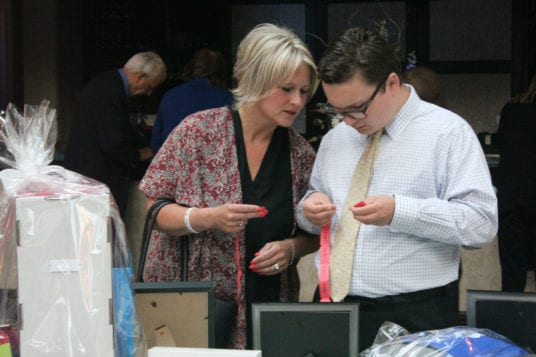By Kevin Redding
When it comes to revitalization, Huntington Station is building a future as solid as steel.
Supervisor Frank Petrone (D) could barely contain his excitement June 8 as he, along with town board members and developers, kicked off Huntington Station’s long-planned revitalization phase with the signing of a steel beam to be installed over the entrance of a new, mixed-use building currently under construction at the intersection of Northridge Street and New York Avenue, a site on which the town has been trying to develop a property for decades.
“Finally, this is happening,” Petrone said to cheers and applause from at least 50 residents and local leaders standing in front of the construction site. “All of you who are here have been inspirational in his whole process and we know it’s taken a long time, but it’s happened…and thank goodness it’s happened.”
The mixed-use building, under construction since January and expected to be completed in October, will be made up of 6500 square feet of retail space on the first floor, with May’s Gourmet Delicatessen signed up as the first and only commercial tenant so far, and a total of 16 one-bedroom apartments, eight on the second floor and eight on the third, for a total cost of $5.5 million. According to the town, it’s projected to “generate $55,007 in tax revenue the first year, rising to $132,016 (at present rates) in 15 years.”

This will serve as the first concrete project in Huntington Station’s next phase of youth-friendly revitalization and was developed in partnership with Renaissance Downtowns, a nationally-renowned development group chosen by the town to be a master developer in 2011. Blue & Gold Holdings, a Huntington-based contracting business, is in charge of construction.
“We’re going to attract millennials to this facility, and that speaks highly because the station is a hub, the station is a nucleus of people that commute, especially, and that’s who we are looking to attract,” Petrone said. “There was considerable money put into this, and commitment, because that’s the commitment necessary to start the engine of economic development. The collective work with the communities, with Renaissance Downtowns and with the town has paid off.”
Town Councilman Mark Cuthbertson (D) and Councilwoman Susan Berland (D), both integral players in the town’s revitalization efforts, were equally excited about the progress being made on the site.
“Today is a great day for Huntington Station,” Cuthbertson said. “Anytime we can see brick, mortar and steel [in Huntington Station] with housing going up is a good sign. We have beautiful mixed-use buildings like this going up in Huntington Village that really, really add to the downtown area…but when we can have a building like this, when the economics are right, when government and the private sector come together and are able to do this in Huntington Station, we’re certainly on the right track.”
Berland assured the crowd that although it’s been long in the making, the project will be worth the wait.
“The businesses that are going to happen here and the people who are going to be able to move in to the heart of the station and live here and prosper here and shop here —it’s going to be fantastic,” Berland said. “It’s a beautiful design and it’s going to be a beautiful project when it’s done and we wish everybody who’s going to move in here lots and lots of happiness and years of shopping in Huntington and spending your money. They say the best things in life are worth waiting for and, well, this is absolutely worth waiting for.”
Don Monti, chairman of Renaissance Downtowns, referring to Petrone, said, “Huntington Station is something he’s wanted to see developed for many years and I’m happy and proud that prior to the supervisor departing that the dream has come true…and this is just a beginning… the first of many to come.”
“We’re going to attract millennials to this facility, and that speaks highly because the station is a hub, the station is a nucleus of people that commute, especially, and that’s who we are looking to attract.”
— Frank Petrone
Future projects proposed by Renaissance Downtowns, currently in the approval process, include a mixed-use building at the intersection of New York Avenue and Olive Street that will include 66 apartments and ground-level retail, a hotel and office building at New York Avenue and Railroad Street, and artists’ studios in what is currently a municipal parking lot at New York Avenue and Church Street.
Dolores Thompson, a community activist for more than 70 years and the mother of Town Councilwoman Tracey Edwards (D), said she’s been trying to bring back Huntington Station since it was “taken away in the 1950s.”
“This is one of the things that I wanted to see before I leave this world and to be here today and be able to witness the fact that we actually have started is like a blessing…I’m so pleased to be here,” Thompson said. In terms of what she hopes will come to Huntington Station, she laughed, “We need a hair salon, then a shoe store, we want a gathering place and a community room…we want everything, okay?”
Robert Rockelein, a member of the civic group Huntington Matters, called this “progress in the right direction.”
“The revitalization has been backsliding for decades, it’s long overdue and it’s going to help populate and reflourish the downtown area,” Rockelein said. “I’d like to see more neighborhood-established businesses rather than regional chains obviously, and give people that live and work here an opportunity to establish something here and build their American dream.”
Local leaders, developers and residents each took turns signing their names on the last piece of steel to be installed on the mixed-use building, which will be placed at the entrance.


































